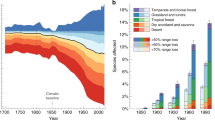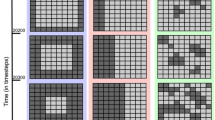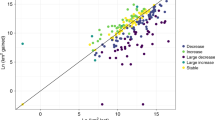Abstract
As one moves from the core to the periphery of a species' geographical range, populations occupy less favourable habitats and exhibit lower and more variable densities1,2,3,4. Populations along the periphery of the range tend to be more fragmented and, as a result, are less likely to receive immigrants from other populations. A population's probability of extinction is directly correlated with its variability and inversely correlated with density and immigration rate5,6,7,8,9. This has led to the prediction that, when a species becomes endangered, its geographical range should contract inwards, with the core populations persisting until the final stages of decline2,10. Convinced by these logical but untested deductions, conservation biologists and wildlife managers have been instructed to avoid the range periphery when planning conservation strategies or allocating resources for endangered species11,12,13. We have analysed range contraction in 245 species from a broad range of taxonomic groups and geographical regions. Here we report that observed patterns of range contraction do not support the above predictions and that most species examined persist in the periphery of their historical geographical ranges.
This is a preview of subscription content, access via your institution
Access options
Subscribe to this journal
Receive 51 print issues and online access
$199.00 per year
only $3.90 per issue
Buy this article
- Purchase on Springer Link
- Instant access to full article PDF
Prices may be subject to local taxes which are calculated during checkout


Similar content being viewed by others
References
Brown,J. H. On the relationship between abundance and distribution of species. Am. Nat. 124, 255–279 ( 1984).
Lawton,J. H. in Extinction Rates (eds Lawton, J. H. & May, R. M.) 147– 163 (Oxford Univ. Press, 1995).
Brown,J. H., Mehlman,D. W. & Stevens, G. C. Spatial variation in abundance. Ecology 76, 2028–2043 ( 1995).
Gaston,K. J. Patterns in the geographical ranges of species. Biol. Rev. 65, 105–129 (1990).
MacArthur,R. H. & Wilson,E. O. The theory of island biogeography. Monogr. Popul. Biol. 1, 1–203 (1967).
Pimm,S. L., Jones,H. L. & Diamond, J. On the risk of extinction. Am. Nat. 132, 757–785 (1988).
Tracy,C. R. & George,T. L. On the determinants of extinction. Am. Nat. 139, 102–122 (1992).
Brown,J. H. & Kodric-Brown,A. Turnover rates in insular biogeography: effects of immigration on extinction. Ecology 58, 445–449 (1977).
Goel,N. S. & Richter-Dyn,N. Stochastic Models in Biology (Academic, New York, 1974).
Brown,J. H. Macroecology (Univ. Chicago Press, 1995).
Wolf,C. M., Griffith,B., Reed,C. & Temple,S. A. Avian and mammalian translocations: update and reanalysis of 1987 survey data. Conserv. Biol. 10, 1142–1153 ( 1996).
Griffith,B., Scott,J. M., Carpenter,J. W. & Reed,C. Translocation as a species conservation tool: status and strategy. Science 245, 477–480 ( 1989).
Pearl,M. in Conservation Biology: The Theory and Practice of Nature Conservation Preservation and Management (eds Fielder, P. L. & Jain, S. K.) 297– 320 (Chapman & Hall, New York, 1992).
Martin,P. S. in Quaternary Extinctions (eds Martin, P. S. & Klein, R. G.) 354–403 (Univ. Arizona Press, Tucson 1984).
Diamond,J. M. in Quaternary Extinctions (eds Martin, P. S. & Klein, R. G.) 824–862 (Univ. Arizona Press, Tucson, 1984).
Burbidge,A. A. & McKenzie,N. L. Patterns in the modern decline of western Australia's vertebrate fauna: causes and conservation implications. Biol. Conserv. 50, 143– 198 (1989).
Short,J., Bradshaw,S. D., Giles,J., Prince,R. I. T. & Wilson, G. R. Reintroduction of macropods (Marsupialia: Macropodoidea) in Australia—A review. Biol. conserv. 62, 189–204 (1992).
Bibby,C. J. Recent past and future extinctions in birds. Phil. Trans. R. Soc. Lond. B 344, 35–40 ( 1994).
Franklin,J. & Steadman,D. W. The potential for conservation of Polynesian birds through habitat mapping and species translocation. Conserv. Biol. 5, 506–521 (1991).
Towns,D. R. & Daugherty,C. H. Patterns of range contractions and extinctions in the New Zealand herpetofauna following human colonisation. N.Z. J. Zool. 21, 325– 339 (1994).
Stevens,G. in Systematics, Ecology, and the Biodiversity Crisis (ed. Eldredge, N.) 40–58 (Columbia Univ. Press, New York, 1992).
Wolf,C. M., Griffith,B., Reed,C. & Temple,S. A. Avian and mammalian translocations: update and reanalysis of 1987 survey data. Conserv. Biol. 10, 1142–1153 ( 1996).
Eastman,J. R. Idrisi for Windows, Version 1.0 (Clark Labs for Cartographic Technology and Geographic Analysis, Worcester, MA, 1995).
Channell,R. A geography of extinction: patterns in the contraction of geographic ranges. Thesis, Univ. Oklahoma (1998).
Acknowledgements
We thank A. Baynes, J. H. Brown, N. Czaplewski, B. Danielson, T. Franklin, M. Kaspari, B. Maurer, K. Pandora, D. Perault, K. Perez, S. Pimm, G. A. Smith and C. Vaughn for advice and comments on this paper, and J. M. Scott, D. Steadman and L. Carbyn for information on the distribution of several species. R.C. was supported by the Department of Zoology, University of Oklahoma, while conducting this research, and M.V.L. was supported by grants from the US National Science Foundation.
Author information
Authors and Affiliations
Corresponding author
Supplementary information
Rights and permissions
About this article
Cite this article
Channell, R., Lomolino, M. Dynamic biogeography and conservation of endangered species. Nature 403, 84–86 (2000). https://doi.org/10.1038/47487
Received:
Accepted:
Issue Date:
DOI: https://doi.org/10.1038/47487
This article is cited by
-
Reconstructing colonization dynamics to establish how human activities transformed island biodiversity
Scientific Reports (2024)
-
Genetic and demographic consequences of range contraction patterns during biological annihilation
Scientific Reports (2023)
-
Nonspreading solutions and patch formation in an integro-difference model with a strong Allee effect and overcompensation
Theoretical Ecology (2023)
-
Whole genome sequencing reveals high differentiation, low levels of genetic diversity and short runs of homozygosity among Swedish wels catfish
Heredity (2021)
-
Making the connection: combining habitat suitability and landscape connectivity to understand species distribution in an agricultural landscape
Landscape Ecology (2021)
Comments
By submitting a comment you agree to abide by our Terms and Community Guidelines. If you find something abusive or that does not comply with our terms or guidelines please flag it as inappropriate.



